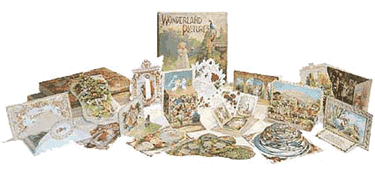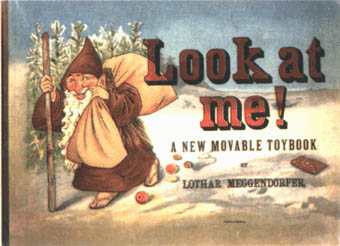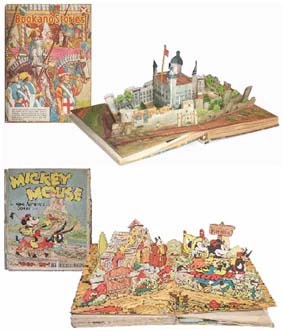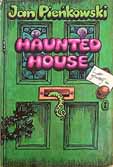A short history of paper engineering and
pop-up books
'Pop-up book' has become the generally
recognised term to describe any book that contains three-dimensional
paper pictures or any interactive element such as flaps or pull-tabs
made from paper. 'Pop-up' was in fact registered as a trade mark in
the USA by Blue Ribbon Books Inc., of New York between the two world
wars. These 'magical' books that conceal within their two
dimensional covers magnificent structures and mechanisms have become
very popular in recent years, but in fact, they have a very ancient
history.The first known examples of an 'interactive' element in a
book date back to the 13th century. These early documents,
hand-written of course, contained what are called 'volvelles'.
Volvelles were basically discs with a central pivot that could be rotated to reveal, or point to, words or symbols on the page. The books were often mystical in subject using the volvelles to foretell the future or in some cases, create secret codes. By the 14th century, some scholars working in their scriptoriums were using paper flaps to superimpose layers of the human body in their detailed books about human anatomy. In 1583, a book produced by a Dresden scholar, was an anatomical study 2. which contained diagrams detailing the hand and eye using five or six superimposed layers. After this, there was little technical development in paper engineering until the late 18th century, when the combination of cheaper and better printing and the increasingly literate society, began to create a demand for books and, in particular, books for entertainment. A totally new market had emerged - the book for children. It is very debatable what was the first pop-up book aimed specifically at children but by the 1820s, books with the unappealing name 'toilet books' published by Stacey Grinaldi, were becoming fashionable. These were essentially 'lift the flap' books. The company of Dean & Son of London are claimed to be the true originators of childrens' pop-up books. Dean & Son successfully marketed about 50 different titles of movable and pop-up books
Meggendorfer,born in Munich, Germany in 1847, was an innovative master of paper engineering but he also had an acute eye for the absurdities of life.He managed, with highly ingenious and complicated mechanisms, to animate scenes and to make wry comments about the people portrayed.Despite their delicate structure and expense, his books sold throughout the world being translated into many languages.
The First World War (1914 - 1918) brought to an end this golden era and it was several years before the publishing industry again regained the confidence to experiment with paper engineered books. During the inter-war period in Britain, the 'Bookano' series of books represented some of the most elaborate examples and 'Blue Ribbon Books Inc.' of New York was the foremost publisher. Both these publishers used the occasional pop-up picture inserted into an otherwise traditional story book. The mechanics were elaborate but the strength and quality of the paper was poor (by modern standards) and so few of the books of this period have survived the roughness of childish appreciation.During the inter-war period in Britain, the 'Bookano' series of books represented some of the most elaborate examples and 'Blue Ribbon Books Inc.' of New York was the foremost publisher. Both these publishers used the occasional pop-up picture inserted into an otherwise traditional story book. The mechanics were elaborate but the strength and quality of the paper was poor (by modern standards) and so few of the books of this period have survived the roughness of childish appreciation.
The second World War presented another interuption to the development of the pop-up and apart from paper engineered greeting cards and relatively simple pop-up books, where the pictures 'pushed-up' without the need of glue-tabs, there was relatively little interest in the medium during the 1950s and early 1960s.
The chief entrepreneur who is responsible for reviving the genre was an American called Waldorf Hunt. In 1974 he created a company called Intervisual Communications Inc. By using some of the best paper engineers in the world, such as Tor Lokvig, his company started to raise the calibre and quality of pop-up books. The beginning of the 'New Wave' of pop-up books that we still relish today, began with the revolutionary Haunted House by Jan Pienkowski. Pienkowski, stubbornly cajoled the paper engineer Tor Lokvig and Wally Hunt into publishing a pop-up book that contained not just one but several mechanisms on each page. The book enraptured readers and was a runaway success. A market existed that no one had realised before. Soon afterwards, the British designer David Pelham had an idea inspired by the elaborately illustrated Victorian medical books with their coloured engravings and flaps (the same principle as the very first mediaeval flap books!). With the help of one of the greatest British paper engineers, Vic Duppa-White, they created an elaborate pop-up book designed to use 'animated' diagrams to communicate the way certain human organs functioned.
Ron van der Meer, a Dutchman who had graduated from the Royal College of Art in London, was becoming well respected as an illustrator of childrens' books and designer of educational toys. He realised that the strength of modern papers and glues meant that it would be possible to make an elaborate yet rugged pop-up book for children. Ron approached Wally Hunt with his idea for his first pop-up book called Monster Island . The novel feature of this book was that the child reader was taken on a 3-D journey. Rather than the pop-ups merely being passive illustrations, the reader had to interact with the mechanisms in the book to develop the story. An ideal opportunity for parent and child to experience the adventure together. With the techniques and market established for the modern pop-up, Ron persuaded Wally to publish his latest ideafor a pop-up book . Sailing Ships (1984) was a truly sophisticated pop-up book aimed at the adult reader called. The awe inspiring pop-ups of this book meant that it became a prizewinning classic and is regularly reprinted. With the markets firmly established for pop-ups, there was an explosion in the number of publishers producing pop-up books. Many of the books were second rate, merely trying to cash in on the market but most were very high quality well engineered books. The National Geographic series, paper engineered by two of the masters of the art Jim Dias and John Strejan, set new standards of paper engineering.
The next great-leap-forward came again from
Ron van der Meer - 'The Pack'. Ron's background in educational toys
had always illustrated to him the truth of the old Chinese proverb
"to hear is to forget, to see is to remember, to do is to
understand". His latest book was an elaborate combination of
pop-ups, flaps, fold-outs and an explanatory cassette tape all
contained within a book with a shallow tray in the back.
The
title was The Art Pack and set out to demistify the world of art by
avoiding the pompousness of many books on the subject but without
being patronising. The success of The Art Pack has lead to a
succession of equally elaborate Packs which provide the core of his
new publishing company's oeuvre.
There are only a few fine
paper engineers in the world today who are exploring new ideas and
ways of making intriguing books. One of the most ingenious is Robert
Sabuda who stunned the pop-up world with his elaborate minimalist
mechanisms (The Christmas Alphabet 1996). The sheer elegance of his
plain white pop-ups and die-cutting demonstrated how sophisticated
pop-ups can look.
Modern pop-ups are manufactured by a very
few specialist factories in Colombia, China and Thailand. All the
books have to be hand-assembled after the sheets have been printed
and die-cut. The expertise of the die-cutters and assemblers takes
years of experience to learn. Before the printing of a new title,
the production specialists at the factories have to carefully
dismantle and examine a dummy, provided by the paper engineer, to
establish exactly what stages, and in what order, the assembly must
take place.
For instance, a Van der Meer Pack is assembled
from about 600 separate pieces and every assembled mechanism must be
carefully checked for fit and function. The overall time, from
concept to delivery of a complex book, can take two years of hard
and detailed work involving the cooperation of paper engineer,
designer (usually the same person at Van der Meer Publishing),
author, illustrator and specialist printer.



